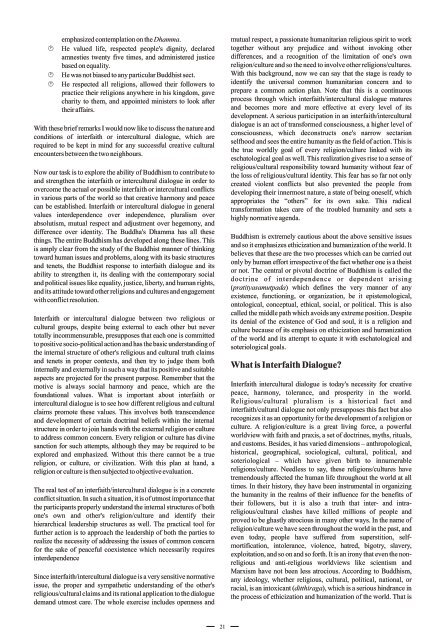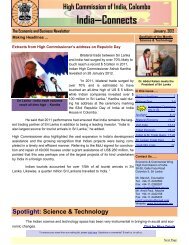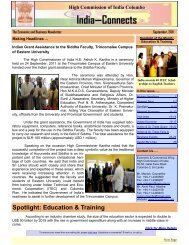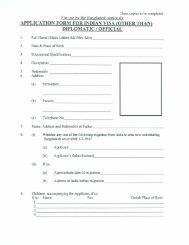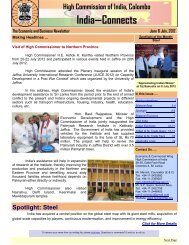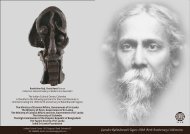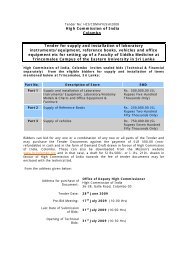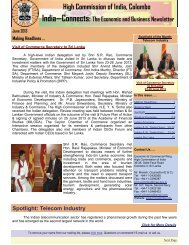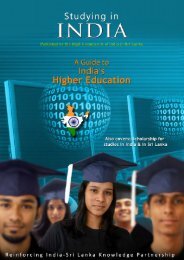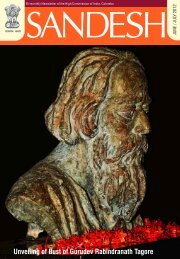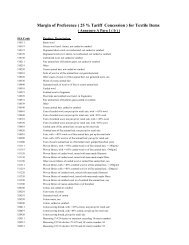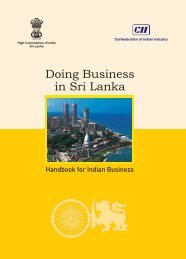Papers presented at the International Buddhist Conference, March ...
Papers presented at the International Buddhist Conference, March ...
Papers presented at the International Buddhist Conference, March ...
Create successful ePaper yourself
Turn your PDF publications into a flip-book with our unique Google optimized e-Paper software.
emphasized contempl<strong>at</strong>ion on <strong>the</strong> Dhamma.<br />
He valued life, respected people's dignity, declared<br />
amnesties twenty five times, and administered justice<br />
based on equality.<br />
He was not biased to any particular <strong>Buddhist</strong> sect.<br />
He respected all religions, allowed <strong>the</strong>ir followers to<br />
practice <strong>the</strong>ir religions anywhere in his kingdom, gave<br />
charity to <strong>the</strong>m, and appointed ministers to look after<br />
<strong>the</strong>ir affairs.<br />
With <strong>the</strong>se brief remarks I would now like to discuss <strong>the</strong> n<strong>at</strong>ure and<br />
conditions of interfaith or intercultural dialogue, which are<br />
required to be kept in mind for any successful cre<strong>at</strong>ive cultural<br />
encounters between <strong>the</strong> two neighbours.<br />
Now our task is to explore <strong>the</strong> ability of Buddhism to contribute to<br />
and streng<strong>the</strong>n <strong>the</strong> interfaith or intercultural dialogue in order to<br />
overcome <strong>the</strong> actual or possible interfaith or intercultural conflicts<br />
in various parts of <strong>the</strong> world so th<strong>at</strong> cre<strong>at</strong>ive harmony and peace<br />
can be established. Interfaith or intercultural dialogue in general<br />
values interdependence over independence, pluralism over<br />
absolutism, mutual respect and adjustment over hegemony, and<br />
difference over identity. The Buddha's Dhamma has all <strong>the</strong>se<br />
things. The entire Buddhism has developed along <strong>the</strong>se lines. This<br />
is amply clear from <strong>the</strong> study of <strong>the</strong> <strong>Buddhist</strong> manner of thinking<br />
toward human issues and problems, along with its basic structures<br />
and tenets, <strong>the</strong> <strong>Buddhist</strong> response to interfaith dialogue and its<br />
ability to streng<strong>the</strong>n it, its dealing with <strong>the</strong> contemporary social<br />
and political issues like equality, justice, liberty, and human rights,<br />
and its <strong>at</strong>titude toward o<strong>the</strong>r religions and cultures and engagement<br />
with conflict resolution.<br />
Interfaith or intercultural dialogue between two religious or<br />
cultural groups, despite being external to each o<strong>the</strong>r but never<br />
totally incommensurable, presupposes th<strong>at</strong> each one is committed<br />
to positive socio-political action and has <strong>the</strong> basic understanding of<br />
<strong>the</strong> internal structure of o<strong>the</strong>r's religious and cultural truth claims<br />
and tenets in proper contexts, and <strong>the</strong>n try to judge <strong>the</strong>m both<br />
internally and externally in such a way th<strong>at</strong> its positive and suitable<br />
aspects are projected for <strong>the</strong> present purpose. Remember th<strong>at</strong> <strong>the</strong><br />
motive is always social harmony and peace, which are <strong>the</strong><br />
found<strong>at</strong>ional values. Wh<strong>at</strong> is important about interfaith or<br />
intercultural dialogue is to see how different religious and cultural<br />
claims promote <strong>the</strong>se values. This involves both transcendence<br />
and development of certain doctrinal beliefs within <strong>the</strong> internal<br />
structure in order to join hands with <strong>the</strong> external religion or culture<br />
to address common concern. Every religion or culture has divine<br />
sanction for such <strong>at</strong>tempts, although <strong>the</strong>y may be required to be<br />
explored and emphasized. Without this <strong>the</strong>re cannot be a true<br />
religion, or culture, or civiliz<strong>at</strong>ion. With this plan <strong>at</strong> hand, a<br />
religion or culture is <strong>the</strong>n subjected to objective evalu<strong>at</strong>ion.<br />
The real test of an interfaith/intercultural dialogue is in a concrete<br />
conflict situ<strong>at</strong>ion. In such a situ<strong>at</strong>ion, it is of utmost importance th<strong>at</strong><br />
<strong>the</strong> participants properly understand <strong>the</strong> internal structures of both<br />
one's own and o<strong>the</strong>r's religion/culture and identify <strong>the</strong>ir<br />
hierarchical leadership structures as well. The practical tool for<br />
fur<strong>the</strong>r action is to approach <strong>the</strong> leadership of both <strong>the</strong> parties to<br />
realize <strong>the</strong> necessity of addressing <strong>the</strong> issues of common concern<br />
for <strong>the</strong> sake of peaceful coexistence which necessarily requires<br />
interdependence<br />
Since interfaith/intercultural dialogue is a very sensitive norm<strong>at</strong>ive<br />
issue, <strong>the</strong> proper and symp<strong>at</strong>hetic understanding of <strong>the</strong> o<strong>the</strong>r's<br />
religious/cultural claims and its r<strong>at</strong>ional applic<strong>at</strong>ion to <strong>the</strong> dialogue<br />
demand utmost care. The whole exercise includes openness and<br />
mutual respect, a passion<strong>at</strong>e humanitarian religious spirit to work<br />
toge<strong>the</strong>r without any prejudice and without invoking o<strong>the</strong>r<br />
differences, and a recognition of <strong>the</strong> limit<strong>at</strong>ion of one's own<br />
religion/culture and so <strong>the</strong> need to involve o<strong>the</strong>r religions/cultures.<br />
With this background, now we can say th<strong>at</strong> <strong>the</strong> stage is ready to<br />
identify <strong>the</strong> universal common humanitarian concern and to<br />
prepare a common action plan. Note th<strong>at</strong> this is a continuous<br />
process through which interfaith/intercultural dialogue m<strong>at</strong>ures<br />
and becomes more and more effective <strong>at</strong> every level of its<br />
development. A serious particip<strong>at</strong>ion in an interfaith/intercultural<br />
dialogue is an act of transformed consciousness, a higher level of<br />
consciousness, which deconstructs one's narrow sectarian<br />
selfhood and sees <strong>the</strong> entire humanity as <strong>the</strong> field of action. This is<br />
<strong>the</strong> true worldly goal of every religion/culture linked with its<br />
esch<strong>at</strong>ological goal as well. This realiz<strong>at</strong>ion gives rise to a sense of<br />
religious/cultural responsibility toward humanity without fear of<br />
<strong>the</strong> loss of religious/cultural identity. This fear has so far not only<br />
cre<strong>at</strong>ed violent conflicts but also prevented <strong>the</strong> people from<br />
developing <strong>the</strong>ir innermost n<strong>at</strong>ure, a st<strong>at</strong>e of being oneself, which<br />
appropri<strong>at</strong>es <strong>the</strong> “o<strong>the</strong>rs” for its own sake. This radical<br />
transform<strong>at</strong>ion takes care of <strong>the</strong> troubled humanity and sets a<br />
highly norm<strong>at</strong>ive agenda.<br />
Buddhism is extremely cautious about <strong>the</strong> above sensitive issues<br />
and so it emphasizes ethiciz<strong>at</strong>ion and humaniz<strong>at</strong>ion of <strong>the</strong> world. It<br />
believes th<strong>at</strong> <strong>the</strong>se are <strong>the</strong> two processes which can be carried out<br />
only by human effort irrespective of <strong>the</strong> fact whe<strong>the</strong>r one is a <strong>the</strong>ist<br />
or not. The central or pivotal doctrine of Buddhism is called <strong>the</strong><br />
doctrine of interdependence or dependent arising<br />
(pr<strong>at</strong>ityasamutpada) which defines <strong>the</strong> very manner of any<br />
existence, functioning, or organiz<strong>at</strong>ion, be it epistemological,<br />
ontological, conceptual, ethical, social, or political. This is also<br />
called <strong>the</strong> middle p<strong>at</strong>h which avoids any extreme position. Despite<br />
its denial of <strong>the</strong> existence of God and soul, it is a religion and<br />
culture because of its emphasis on ethiciz<strong>at</strong>ion and humaniz<strong>at</strong>ion<br />
of <strong>the</strong> world and its <strong>at</strong>tempt to equ<strong>at</strong>e it with esch<strong>at</strong>ological and<br />
soteriological goals.<br />
Wh<strong>at</strong> is Interfaith Dialogue?<br />
Interfaith intercultural dialogue is today's necessity for cre<strong>at</strong>ive<br />
peace, harmony, tolerance, and prosperity in <strong>the</strong> world.<br />
Religious/cultural pluralism is a historical fact and<br />
interfaith/cultural dialogue not only presupposes this fact but also<br />
recognizes it as an opportunity for <strong>the</strong> development of a religion or<br />
culture. A religion/culture is a gre<strong>at</strong> living force, a powerful<br />
worldview with faith and praxis, a set of doctrines, myths, rituals,<br />
and customs. Besides, it has varied dimensions – anthropological,<br />
historical, geographical, sociological, cultural, political, and<br />
soteriological – which have given birth to innumerable<br />
religions/culture. Needless to say, <strong>the</strong>se religions/cultures have<br />
tremendously affected <strong>the</strong> human life throughout <strong>the</strong> world <strong>at</strong> all<br />
times. In <strong>the</strong>ir history, <strong>the</strong>y have been instrumental in organizing<br />
<strong>the</strong> humanity in <strong>the</strong> realms of <strong>the</strong>ir influence for <strong>the</strong> benefits of<br />
<strong>the</strong>ir followers, but it is also a truth th<strong>at</strong> inter- and intrareligious/cultural<br />
clashes have killed millions of people and<br />
proved to be ghastly <strong>at</strong>rocious in many o<strong>the</strong>r ways. In <strong>the</strong> name of<br />
religion/culture we have seen throughout <strong>the</strong> world in <strong>the</strong> past, and<br />
even today, people have suffered from superstition, selfmortific<strong>at</strong>ion,<br />
intolerance, violence, h<strong>at</strong>red, bigotry, slavery,<br />
exploit<strong>at</strong>ion, and so on and so forth. It is an irony th<strong>at</strong> even <strong>the</strong> nonreligious<br />
and anti-religious worldviews like scientism and<br />
Marxism have not been less <strong>at</strong>rocious. According to Buddhism,<br />
any ideology, whe<strong>the</strong>r religious, cultural, political, n<strong>at</strong>ional, or<br />
racial, is an intoxicant (ditthiraga), which is a serious hindrance in<br />
<strong>the</strong> process of ethiciz<strong>at</strong>ion and humaniz<strong>at</strong>ion of <strong>the</strong> world. Th<strong>at</strong> is<br />
21


